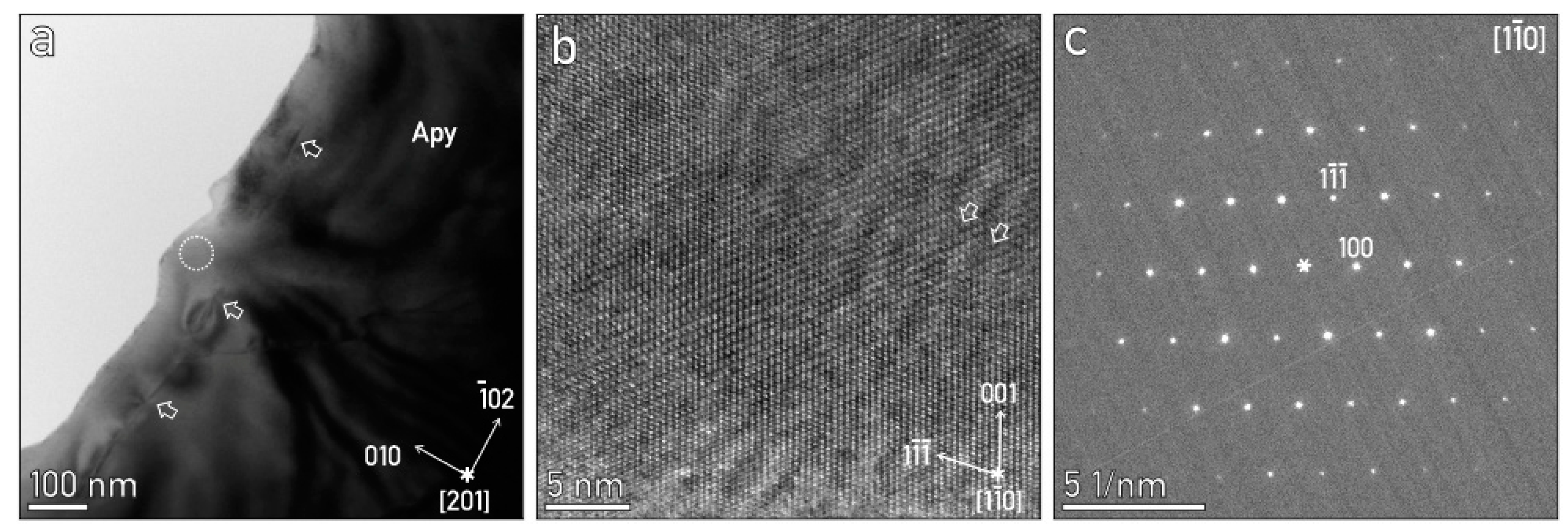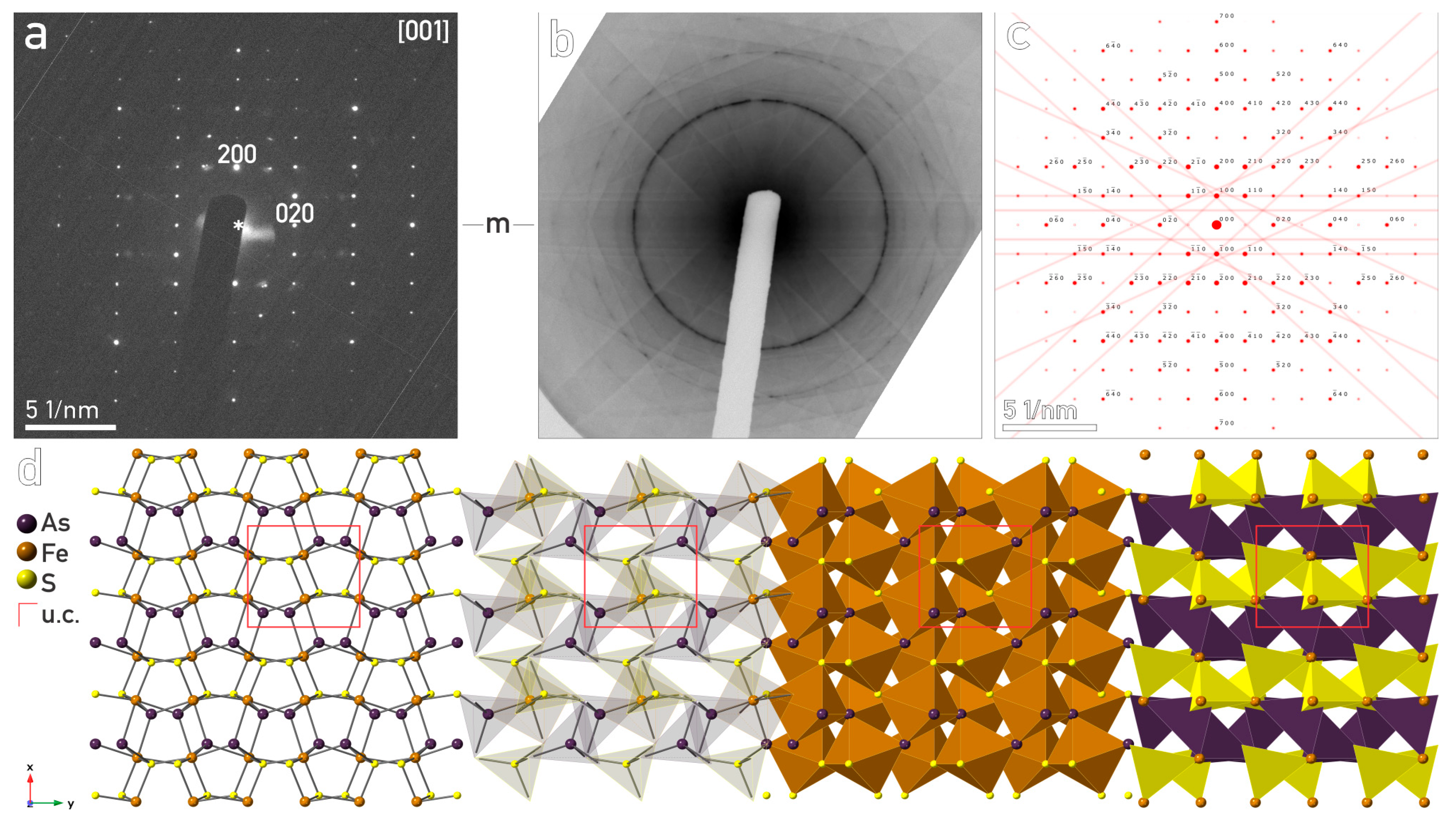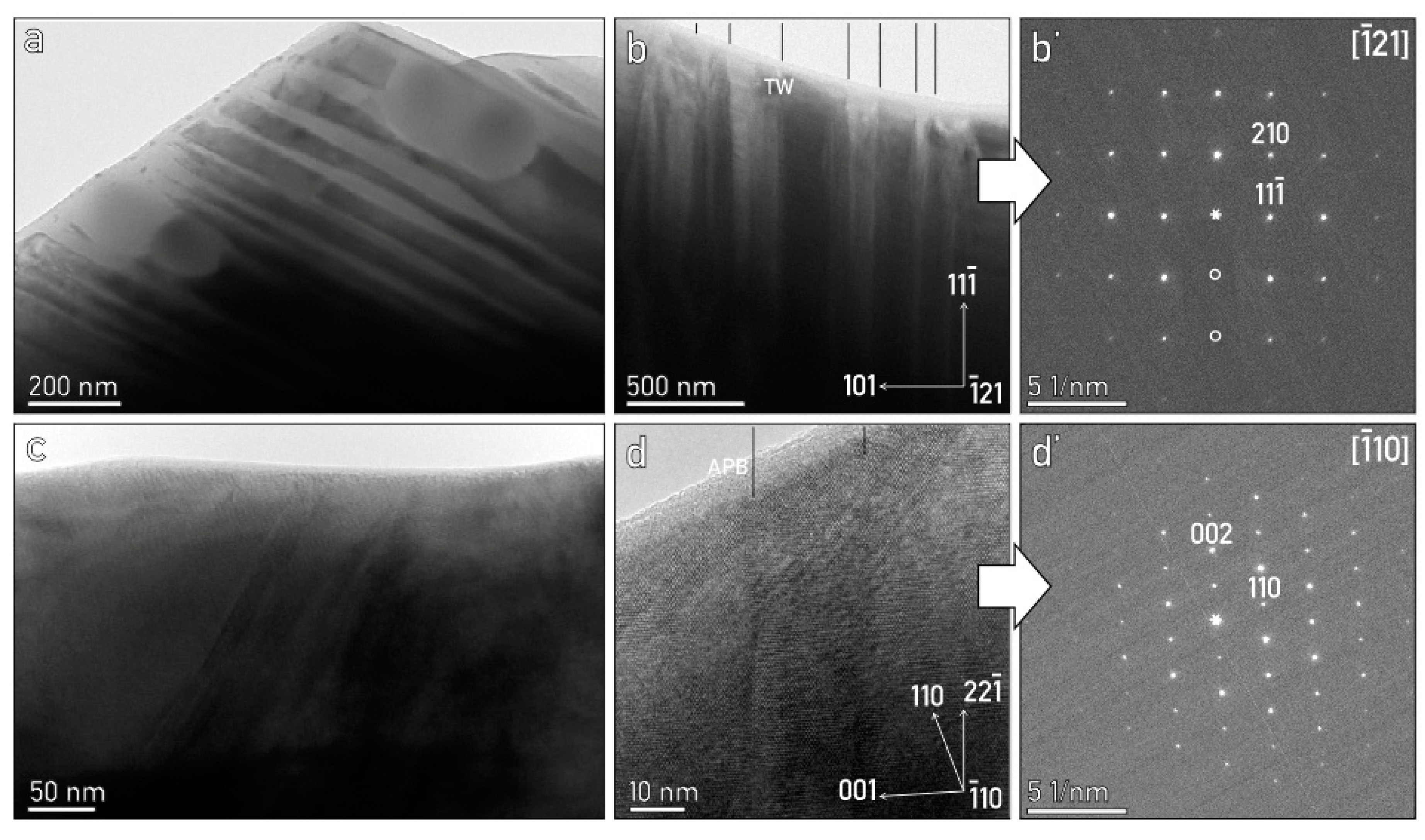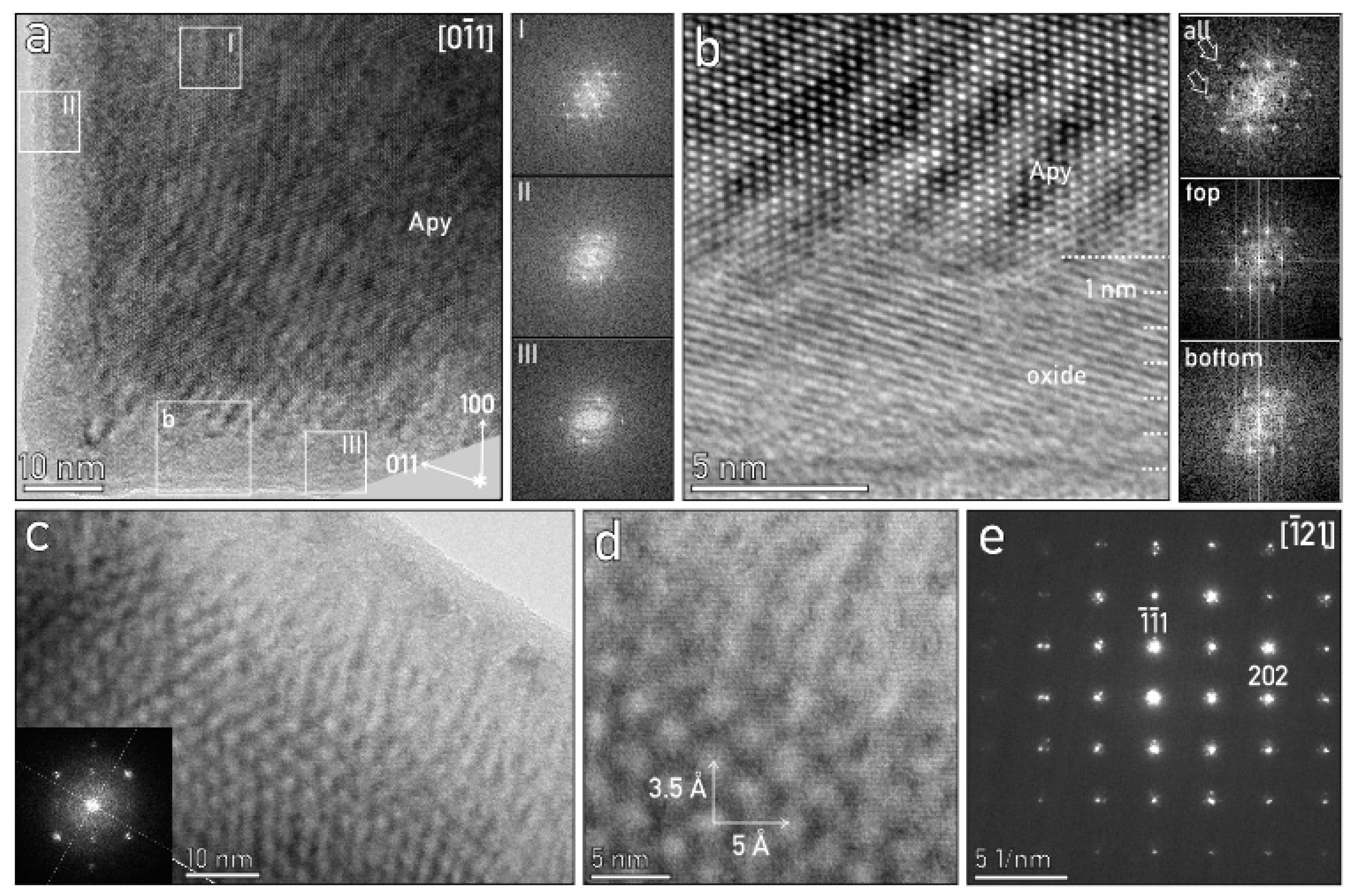Crystallography and Surface Oxidation of Stoichiometric Arsenopyrite from Šumadija-Kopaonik Pb-Zn/Polymetallic Ore District (Serbia)
Abstract
1. Introduction
2. Materials and Methods
2.1. Scanning Electron Microscopy and Energy Dispersive X-ray Spectroscopy (SEM-EDS)
2.2. X-ray Powder Diffraction (XRPD)
2.3. Transmission Electron Microscopy (TEM)
3. Results and Discussion
3.1. X-ray Powder Diffraction (XRPD)
3.2. Transmission Electron Microscopy (TEM)
4. Conclusions
- -
- By studying arsenopyrite from different types of mineralisations in the Šumadija-Kopaonik ore area, no correlation was established regarding its composition and different deposition conditions, i.e., different mineral paragenesis.
- -
- The average unit cell parameters measured by XRPD of near-stoichiometric arsenopyrite from the Drenjak locality, as a mean of four measurements, are a = 5.744(8) Å, b = 5.678(55) Å, c = 5.774(03) Å, α, γ = 90°, and ß = 112.05(65) °.
- -
- The unit cell values calculated from the thin TEM sample using selected area electron diffraction (SAED) of the pristine, homogenous region of arsenopyrite crystal are a = 5.75 Å, b = 5.68 Å, c = 5.76 Å, α, γ = 90°, and ß = 111.5 °.
- -
- TEM analysis of analysed arsenopyrite confirms a monoclinic crystal system, space group P21/c. We identified numerous polysynthetic {101} twinning with 50 ± 15 nm thick lamellae. The observed antiphase domain boundaries follow (22-1) planes.
- -
- Upon exposure to air for t > 10 min, a surface crystalline oxide layer is formed. The surface oxide layer is epitaxial, with interplanar distances enlarged by 3.5%in (100) compared to the bulk arsenopyrite structure. The formation of oxides can be avoided by very short sample handling time on air (<5 min).
Supplementary Materials
Author Contributions
Funding
Data Availability Statement
Acknowledgments
Conflicts of Interest
References
- Vaughan, D.J.; Craig, J. Mineral Chemistry of Metal Sulfides; Cambridge University Press: Cambridge, UK, 1978. [Google Scholar]
- Merkulova, M.; Mathon, O.; Glatzel, P.; Rovezzi, M.; Batanova, V.; Marion, P.; Boiron, M.C.; Manceau, A. Revealing the Chemical Form of “Invisible” Gold in Natural Arsenian Pyrite and Arsenopyrite with High Energy-Resolution X-ray Absorption Spectroscopy. ACS Earth Space Chem. 2019, 3, 1905–1914. [Google Scholar] [CrossRef]
- Wang, Z.; Wang, Y.; Peng, E.; Zou, S.; Deng, T.; Lai, F.; Ning, J.; Dong, G.; Xu, D. Micro-Textural and Chemical Fingerprints of Hydrothermal Cobalt Enrichment in the Jingchong Co-Cu Polymetallic Deposit, South China. Ore Geol. Rev. 2022, 142, 104721. [Google Scholar] [CrossRef]
- Chen, J.; Chen, Y.; Wei, Z.; Liu, F. Bulk Flotation of Auriferous Pyrite and Arsenopyrite by Using Tertiary Dodecyl Mercaptan as Collector in Weak Alkaline Pulp. Miner. Eng. 2010, 23, 1070–1072. [Google Scholar] [CrossRef]
- Sung, Y.H.; Brugger, J.; Ciobanu, C.L.; Pring, A.; Skinner, W.; Danyushevsky, L.V.; Nugus, M. Erratum: Invisible Gold in Arsenian Pyrite and Arsenopyrite from a Multistage Archaean Gold Deposit: Sunrise Dam, Eastern Goldfields Province, Western Australia (Mineralium Deposita 10.1007/S00126-009-0244-4). Miner. Depos. 2009, 44, 793. [Google Scholar] [CrossRef]
- Sidorova, N.V.; Aristov, V.V.; Grigor’eva, A.V.; Sidorov, A.A. “Invisible” Gold in Pyrite and Arsenopyrite from The Pavlik Deposit (Northeastern Russia). Dokl. Earth Sci. 2020, 495, 821–826. [Google Scholar] [CrossRef]
- Cabri, L.J.; Newville, M.; Gordon, R.A.; Crozier, E.D.; Sutton, S.R.; McMahon, G.; Jiang, D.T. Chemical Speciation of Gold in Arsenopyrite. Can. Mineral. 2000, 38, 1265–1281. [Google Scholar] [CrossRef]
- Buerger, M.J. The Symmetry and Crystal Structure of the Minerals of the Arsenopyrite Group. Z. Für Krist.-Cryst. Mater. 1936, 95, 83–113. [Google Scholar] [CrossRef]
- Bindi, L.; Moëlo, Y.; Léone, P.; Suchaud, M. Stoichiometric Arsenopyrite, FeAsS, from La Roche-Balue Quarry, Loire-Atlantique, France: Crystal Structure and Mössbauer Study. Can. Mineral. 2012, 50, 471–479. [Google Scholar] [CrossRef]
- Fuess, H.; Kratz, T.; Töpel-Schadt, J.; Miehe, G. Crystal Structure Refinement and Electron Microscopy of Arsenopyrite. Z. Für Krist.-Cryst. Mater. 1987, 179, 335–346. [Google Scholar] [CrossRef]
- González-Jiménez, J.M.; Yesares, L.; Piña, R.; Sáez, R.; de Almodóvar, G.R.; Nieto, F.; Tenorio, S. Polymetallic Nanoparticles in Pyrite from Massive and Stockwork Ores of VMS Deposits of the Iberian Pyrite Belt. Ore Geol. Rev. 2022, 145, 104875. [Google Scholar] [CrossRef]
- Goldmann, S.; Junge, M.; Wirth, R.; Schreiber, A. Distribution of Trace Elements in Sphalerite and Arsenopyrite on the Nanometre-Scale—Discrete Phases versus Solid Solution. Eur. J. Mineral. 2019, 31, 325–333. [Google Scholar] [CrossRef]
- Maksimović, Z.; Divljan, S. The Results of Geological-Petrographic Mapping and Observation of Ore Occurrences in the Areas of Plana and Gokčanica on the Western Slopes of Željin. In Book of Abstracts S.A.N. XXXIII.; Geological Institute S.A.N.: Belgrade, Serbia, 1953; Volume 5, pp. 223–253. [Google Scholar]
- Kretschmar, U.; Scott, S.D. Phase Relations Involving Arsenopyrite in the System Fe-As-S and Their Application. Can. Mineral. 1976, 14, 364–386. [Google Scholar]
- Schmid, S.M.; Bernoulli, D.; Fügenschuh, B.; Matenco, L.; Schefer, S.; Schuster, R.; Tischler, M.; Ustaszewski, K. The Alpine-Carpathian-Dinaridic Orogenic System: Correlation and Evolution of Tectonic Units. Swiss J. Geosci. 2008, 101, 139–183. [Google Scholar] [CrossRef]
- Šoster, A.; Zavašnik, J.; O’Sullivan, P.; Herlec, U.; Potočnik Krajnc, B.; Palinkaš, L.; Zupančič, N.; Dolenec, M. Geochemistry of Bashibos-Bajrambos Metasedimentary Unit, Serbo-Macedonian Massif, North Macedonia: Implications for Age, Provenance and Tectonic Setting. Geochemistry 2020, 80, 125664. [Google Scholar] [CrossRef]
- Craig, J.R.; Vaughan, D.J. Ore Microscopy and Ore Petrography; Wiley-Interscience, Chichester and New York; John Wiley and Sons Ltd.: Hoboken, NJ, USA, 1981; ISBN 0471551759. [Google Scholar]
- Jelić, I.; Pačevski, A.; Kremenović, A.; Šoster, A.; Šestan, A.; Zavašnik, J. XRPD Dataset of Arsenopyrite from Šumadija-Kopaonik Ore District. Mendeley online data repository. Mendeley Data 2023. [Google Scholar] [CrossRef]
- Morimoto, N.; Clark, L.A. Arsenopyrite Crystal-Chemical Relations. Am. Mineral. 1961, 46, 1448–1469. [Google Scholar]
- Watanabe, M.; Williams, D.B. The Quantitative Analysis of Thin Specimens: A Review of Progress from the Cliff-Lorimer to the New ζ-Factor Methods. J. Microsc. 2006, 221, 89–109. [Google Scholar] [CrossRef] [PubMed]
- Williams, D.B.; Carter, C.B. Transmission Electron Microscopy: A Textbook for Materials Science; Winter: New York, NY, USA, 2009; ISBN 9780387765006. [Google Scholar]
- Goldschmidt, V.M. Atlas Der Krystallformen: Plates and Text; Winter: Heidelberg, Germany, 1913; ISBN 9788578110796. [Google Scholar]
- Nesbitt, H.W. Oxidation States and Speciation of Secondary Products on Pyrite and Arsenopyrite Reacted with Mine Waste Waters and Air. Mineral. Petrol. 1998, 62, 123–144. [Google Scholar] [CrossRef]
- Schaufuss, A.G.; Nesbitt, H.W.; Scaini, M.J.; Hoechst, H.; Bancroft, M.G.; Szargan, R. Reactivity of Surface Sites on Fractured Arsenopyrite (FeAsS) toward Oxygen. Am. Mineral. 2000, 85, 1754–1766. [Google Scholar] [CrossRef]
- Owen, N.D.; Ciobanu, C.L.; Cook, N.J.; Slattery, A.; Basak, A. Nanoscale Study of Clausthalite-Bearing Symplectites in Cu-Au-(U) Ores: Implications for Ore Genesis. Minerals 2018, 8, 67. [Google Scholar] [CrossRef]
- Ding, Y.; Veblen, D.R.; Prewitt, C.T. High-Resolution Transmission Electron Microscopy (HRTEM) Study of the 4a and 6a Superstructure of Bornite Cu5FeS4. Am. Mineral. 2005, 90, 1256–1264. [Google Scholar] [CrossRef]
- Reidy, K.; Varnavides, G.; Thomsen, J.D.; Kumar, A.; Pham, T.; Blackburn, A.M.; Anikeeva, P.; Narang, P.; LeBeau, J.M.; Ross, F.M. Direct Imaging and Electronic Structure Modulation of Moiré Superlattices at the 2D/3D Interface. Nat. Commun. 2021, 12, 1290. [Google Scholar] [CrossRef] [PubMed]
- Zavašnik, J.; Šestan, A.; Shvalya, V. Microscopic Techniques for the Characterisation of Metal-Based Nanoparticles. Compr. Anal. Chem. 2021, 93, 241–284. [Google Scholar] [CrossRef]






| Location/ Sample | a [Å] | b [Å] | c [Å] | β [°] | V [Å3] | d131 | at.% As (XRPD) | Impurities [at.%] (SEM-EDS) |
|---|---|---|---|---|---|---|---|---|
| Rudnik | ||||||||
| Rud05/1 | 5.748(2) | 5.680(2) | 5.778(2) | 112.09(1) | 174.8(1) | 1.63207(6) | 33.346(1) | / |
| 39 | 5.750(2) | 5.685(2) | 5.7744(16) | 112.30(1) | 174.95(9) | 1.63248(5) | 33.701(1) | / |
| Rujak | ||||||||
| GKC2017/03 | 5.750(7) | 5.676(7) | 5.768(7) | 111.84(6) | 174.7(4) | 1.6330(1) | 34.143(2) | 0.7 Ni |
| GKC2017/04 | 5.751(3) | 5.676(2) | 5.769(2) | 111.84(2) | 174.8(1) | 1.63138(6) | 32.748(1) | 0.3 Co, 1.5 Ni, 0.2 Sb |
| Drenjak | ||||||||
| T1-1 | 5.749(3) | 5.684(3) | 5.781(3) | 112.13(2) | 175.0(1) | 1.63209(6) | 33.363(1) | 0.3 Co |
| T1-2 | 5.741(5) | 5.679(5) | 5.768(4) | 112.25(1) | 174.2(2) | 1.6315(2) | 32.861(3) | / |
| T1-6 | 5.743(2) | 5.670(2) | 5.772(2) | 111.82(2) | 174.5(1) | 1.63071(3) | 32.1674(6) | / |
| T1-22 | 5.745(2) | 5.680(2) | 5.774(2) | 112.02(1) | 174.6(1) | 1.63172(6) | 33.043(1) | / |
| Sastavci | ||||||||
| SST2017/04 | 5.747(2) | 5.680(2) | 5.777(2) | 112.06(2) | 174.8(1) | 1.6322(1) | 33.433(2) | / |
| SST2017/05 | 5.741(3) | 5.685(4) | 5.778(3) | 112.04(3) | 174.8(2) | 1.63247(4) | 33.6928(8) | 0.3 Sb |
| SST2017/08 | 5.759(7) | 5.685(7) | 5.781(8) | 112.22(6) | 175.2(4) | 1.6321(1) | 33.346(2) | 0.5 Sb, 0.4 Cu |
| Trepča | ||||||||
| Trepča 2 | 5.748(1) | 5.677(2) | 5.780(1) | 112.07(1) | 174.82(8) | 1.63083(7) | 32.271(1) | 0.2 Sb |
| Golijskareka | ||||||||
| G.R. 7.1 | 5.749(2) | 5.686(2) | 5.775(2) | 112.06(1) | 174.97(8) | 1.63318(4) | 34.3086(8) | 1.1 Co |
| Jurija | ||||||||
| CV-J2 | 5.748(2) | 5.684(2) | 5.776(2) | 112.06(2) | 174.9(1) | 1.63304(5) | 34.187(1) | 4.3 Co |
| Ref. | a [Å] | b [Å] | c [Å] | β [°] | V [Å3] | Symmetry | S.G. |
|---|---|---|---|---|---|---|---|
| [8] | 9.51 | 5.65 | 6.42 | 90.0 | 344.956 | monoclinic | B21/d |
| [19] | 5.744 | 5.675 | 5.785 | 112.28 | 174.496 | triclinic | P-1 |
| [10] | 5.741 | 5.649 | 5.756 | 110.588 | 174.750 | monoclinic | P 21/c |
| [9] | 5.7612 | 5.6841 | 5.7674 | 111.721 | 175.456 | monoclinic | P 21/c |
| TEM study | 5.75 | 5.68 | 5.76 | 111.5 | 175.03 | monoclinic | P 21/c |
Disclaimer/Publisher’s Note: The statements, opinions and data contained in all publications are solely those of the individual author(s) and contributor(s) and not of MDPI and/or the editor(s). MDPI and/or the editor(s) disclaim responsibility for any injury to people or property resulting from any ideas, methods, instructions or products referred to in the content. |
© 2023 by the authors. Licensee MDPI, Basel, Switzerland. This article is an open access article distributed under the terms and conditions of the Creative Commons Attribution (CC BY) license (https://creativecommons.org/licenses/by/4.0/).
Share and Cite
Jelić, I.; Pačevski, A.; Kremenović, A.; Šoster, A.; Šestan, A.; Zavašnik, J. Crystallography and Surface Oxidation of Stoichiometric Arsenopyrite from Šumadija-Kopaonik Pb-Zn/Polymetallic Ore District (Serbia). Crystals 2023, 13, 278. https://doi.org/10.3390/cryst13020278
Jelić I, Pačevski A, Kremenović A, Šoster A, Šestan A, Zavašnik J. Crystallography and Surface Oxidation of Stoichiometric Arsenopyrite from Šumadija-Kopaonik Pb-Zn/Polymetallic Ore District (Serbia). Crystals. 2023; 13(2):278. https://doi.org/10.3390/cryst13020278
Chicago/Turabian StyleJelić, Ivana, Aleksandar Pačevski, Aleksandar Kremenović, Aleš Šoster, Andreja Šestan, and Janez Zavašnik. 2023. "Crystallography and Surface Oxidation of Stoichiometric Arsenopyrite from Šumadija-Kopaonik Pb-Zn/Polymetallic Ore District (Serbia)" Crystals 13, no. 2: 278. https://doi.org/10.3390/cryst13020278
APA StyleJelić, I., Pačevski, A., Kremenović, A., Šoster, A., Šestan, A., & Zavašnik, J. (2023). Crystallography and Surface Oxidation of Stoichiometric Arsenopyrite from Šumadija-Kopaonik Pb-Zn/Polymetallic Ore District (Serbia). Crystals, 13(2), 278. https://doi.org/10.3390/cryst13020278






